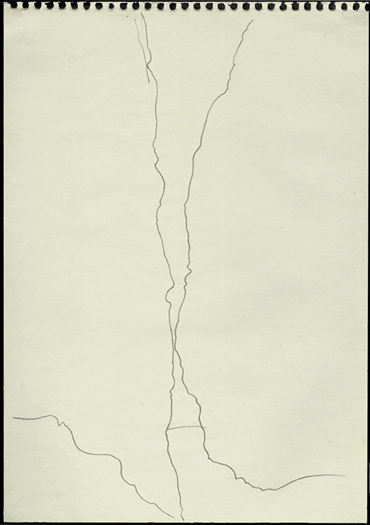The authors memorandum to the drawing of December 1974 "There Are Signs on the Rocks" is a documentary about the brightening of consciousness in elementary art forms, which at this time in the work of Miloš Šejn is realized in direct contact with the rock. This is done by penetrating into the internal relations of the theme and thus creating its exposure in the basic ideological and stylistic context of individual fields. This brightening - the way to the identity of self-consciousness - occurs in an intense accumulation and clash of diverse activities: living in rocky landscapes of the Bohemian Paradise, wandering through gorges and caves (Šejns speleological passion culminates in 1974 - records from autumn indicate the measurement of cave temperatures, 28 October descent to the Lachman Cave in the Prachovské Rocks), art activities (photography and drawing, collecting stones), discovery of some fundamentally close art formulations (H. Moore, P. Klee), university studies focused on art theory, first contact with members of his art generation and finally art training (work in the studio Z. Sýkora at the Faculty of Arts, Charles University in Prague). In the spiritual climate of these activities, in the sense of a personal crisis, the idea of the possibility of uncovering the ever-escaping mystery of the rock landscape is created by creation. For Miloš Šejn, the rock has been an important part of the integral interest in nature since the mid-1960s and is now gradually exposing its semantic carrying capacity.

In the drawing, the primordial clarification is born from the original lyrical vision, poetic stylising ideological symbols, in seeming detours and circular returns, from the dichotomy of drawing records of inner experiences and a detailed examination of the shapes of nature. The drawing of a Slot between Two Sandstone Rocks in the Prachovské Rocks (1974) exceeds the meaning of artistic exploration of natural shapes. It is a thematisation of the experience of man in nature, experiencing the essential connection of man with nature. The gap is most significantly strangeness breaks the barrier between humans and nature. Rock reveals its interior and offers him a vision. Implies a secret contact between the seer and the seen. Seers body belongs also to what it sees, experiencing itself as both inside and outside at the same time. Being body and world as the same substance also experiences the body in seeing the world as "my" world. This feeling is not a metaphor, it is existential, although revealed in imagination. The crevice in the rocks is essentially related to the body itself. (The authenticity of such experiences is also indirectly demonstrated by Miloš Šejns attempt to sense the mystery of their mystery by reading books of Eastern philosophy, whose formulation emphasises "the body as an aspect of the mind" - H. V. Günter and Ch. Trungpa.) The drawing of the slit of 1974 is an experience of this over-substantiation of body and world and thus unintentionally reveals the basic art problem of drawing. Its space is a transformation of the reversible relationship of body and world. It is born in an area of blank paper from the tension of two lines that affect the slit as the approach of two blocks in the lap of rocks. Thus, it does not capture the objective world of bodies, but the seeing of differences, the boundaries of things in relation to the situation of sight. A line is not a feature of an object, it does not imitate visible, but "makes visible" (P. Klee). At the same time, the way the line runs through the paper space, it creates the spaciousness of the things seen as a "constituting emptiness that carries the so-called positivity of things" (M. Merleau Ponty).
Extract from text
THE ROCK by Jan K. Čeliš



 Chasm, 1981 – 1983, oil on canvas
Chasm, 1981 – 1983, oil on canvas
 Academy Archives
Academy Archives 